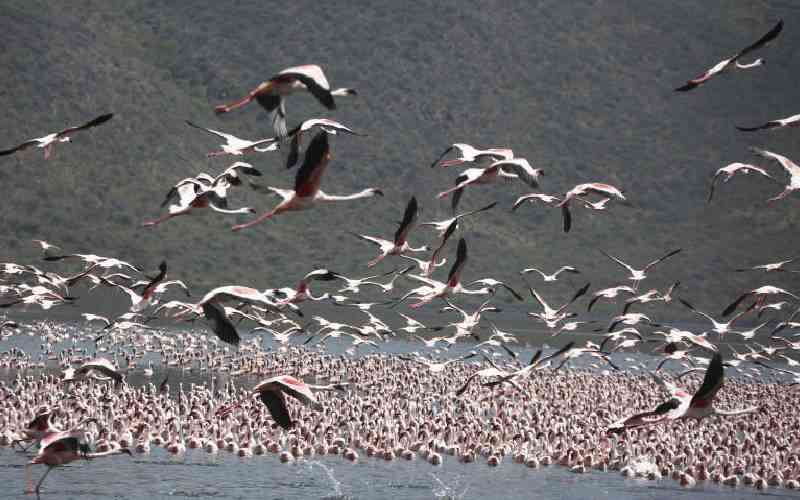 |
|
The rising waters of Lake Baringo have seen several tourist hotels and lodges get partially submerged, destroying tens of millions worth of investments. [Photo: Joseph Kipsang/Standard] |
By Frankline Sunday
Kenya: It is business unusual in Lakes Nakuru, Naivasha, Baringo and Bogoria and the scenes being witnessed are nothing short of a nightmare. The Rift Valley lakes are swelling and sinking under their weight.
A combination of factors including increased rainfall, siltation, underground geological shifts, pollution and cyclical climatic factors have been attributed to the swelling.
The situation is so grave that scientists are stating that the worst is yet to come. They have predicted that the rate of swelling could see “Lake Baringo and Bogoria merge into one”.
Even worse, there has been massive loss of tourism revenue, farming activities, submersion of houses and families moving up the hills to escape the rising water levels.
We are at the shores of Lake Bogoria, one of the lakes in the heart of the Great Rift Valley eco-system where water levels have been on an unprecedented rise over the last three years. It is here that we begin our investigation into what scientists are warning could be the worst ecological disaster in Kenya’s modern history.
The situation has seen a resident, Paulina Kibuon, left homeless. She takes a sharp stick and draws a small straight line in the sandy bed, some two feet from the water’s edge to demonstrate a point.
“That is where our house used to be and that was a school,” explains Paulina. She points to a spot in the water some 200 metres from where we stand. “Every day we woke up to find the water had moved closer. Soon we had no choice but to move,” she adds.
Growing up, Paulina can recount where various landmarks and village infrastructure used to be. Now, everything is covered up by salty lake water.Her husband, Mzee Kibuon, says although there have been varying seasons of dry and wet periods in the past, he has never seen anything like this.
“Every year it rains and the water level rises and falls, but it has never forced us to move from our homes in the 60 years I have lived here,” he states.
With their home gone and their children living in a shelter together with other displaced villagers, Paulina who is six months pregnant and her husband have to figure out where she is going to deliver her new baby when the time comes.
Lake Bogoria is one of the lakes in the Rift Valley where the level of water has been on an increase in the last four years, disrupting both human and animal life. The salt-water lake is the main tourism attraction for the county of Bogoria. At the turn of the century, it had over 1.2 million flamingoes. It is more famous for the hot water springs and geysers.
Tourism affected
James Kimaru, a senior park warden at Lake Bogoria National Reserve says tourist numbers have reduced greatly. An airstrip that used to cater for chartered planes ferrying tourists in and out of the game reserve is currently submerged by water.
A tarmac road that used to lead into the park and the hot springs has disappeared. So have over half of the hot springs and geysers, which used to shoot jets of hot water several feet into the air. The hot springs have remained a major attraction for tourists over the years.
Stay informed. Subscribe to our newsletter
“The lake volume used to be 32km2 and now it is 41km2. The salinity of the water has gone down making the lake almost fresh. This has reduced the number of flamingoes,” says Kimaru.
Flamingoes feed predominantly on a variety of blue-green algae, which grow on salt water and with the water diluted, tens of thousands of flamingoes have migrated out of the lake just as they had fled from Lake Nakuru, which has suffered the same calamity.
“In 2010, the numbers of tourists we received were over 100,000 and in 2012 the numbers were 120,000. In 2013 we had 90,000 visitors,” says Kimaru.
Lake Baringo, another of the lakes that defines the Rift Valley’s diverse eco-systems, is witnessing an equally worrying trend.
The lake used to have an area of 143 kms2 in 2010. It has spread its waters and now covers 231 kms2 as at September last year. That’s a 60 per cent increase in water levels.
Eight primary schools, three health centres, three market centres and a tourist lodge have been swallowed by the flood waters with more infrastructure and homes partially submerged and now totally inaccessible.
Lake Baringo, which is also another major tourism attraction for Baringo County, is home to more than half a dozen lodges and camps that attract many foreign and local tourists.
Lake Baringo Soy Safari Lodge is one of the surviving lodges closest to the swelling lake that has so far been spared from catastrophe and Stephen Maingi, the general manager, says the flooding has had an impact on tourism in Baringo County.
“Several hotels and camping sites are now under water,” he explains. “We have had clients call us and ask if we are still standing. We have even cancelled bookings,” he states.
An overwhelmed county government is trying to grapple with the effect of the flooding. But what is clear is that the administration is ill equipped to execute an effective disaster response.
Baringo Governor Benjamin Cheboi has called on the Government to declare the floods a national disaster. “We have had most of the schools resort to makeshift facilities like tents since the onset of the floods but we are moving to have affected schools move to more permanent structures, which is proving to be expensive,” he explains, adding: “This is a serious disaster and we are working with researchers to understand the causes and what this means for the county. We would also like to appeal to partners and donors to help with the interventions and to research institutions, particularly those interested in issues of climate change.”
The governor is worried the county’s budget cannot cater for the crisis. The county administration had budgeted Sh40 million towards a newly created disaster response unit. Already, about Sh15 million has been spent and the governor states that the extent of flooding demands more resources.
“We need more funds to help rebuild what has been lost and provide food and clothing to victims,” he says.
 The Standard Group Plc is a
multi-media organization with investments in media platforms spanning newspaper
print operations, television, radio broadcasting, digital and online services. The
Standard Group is recognized as a leading multi-media house in Kenya with a key
influence in matters of national and international interest.
The Standard Group Plc is a
multi-media organization with investments in media platforms spanning newspaper
print operations, television, radio broadcasting, digital and online services. The
Standard Group is recognized as a leading multi-media house in Kenya with a key
influence in matters of national and international interest.
 The Standard Group Plc is a
multi-media organization with investments in media platforms spanning newspaper
print operations, television, radio broadcasting, digital and online services. The
Standard Group is recognized as a leading multi-media house in Kenya with a key
influence in matters of national and international interest.
The Standard Group Plc is a
multi-media organization with investments in media platforms spanning newspaper
print operations, television, radio broadcasting, digital and online services. The
Standard Group is recognized as a leading multi-media house in Kenya with a key
influence in matters of national and international interest.










